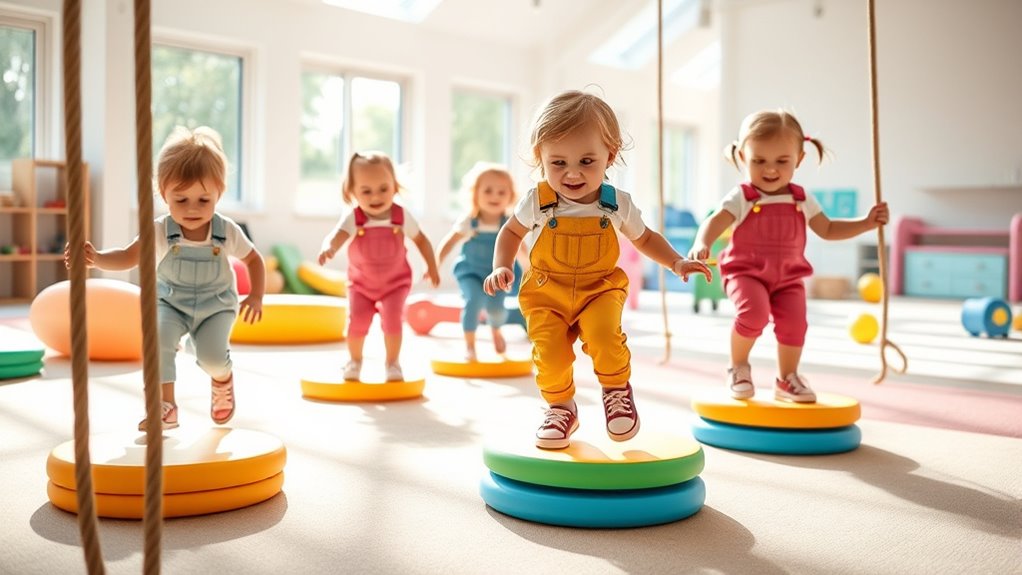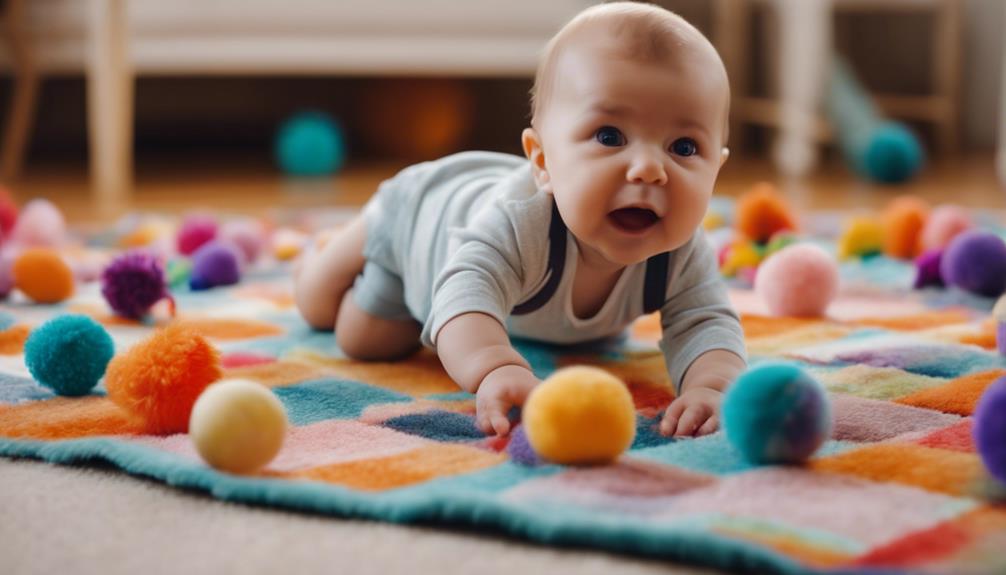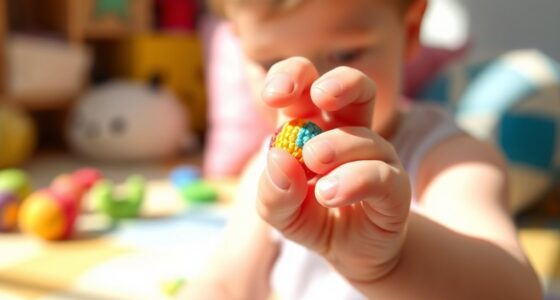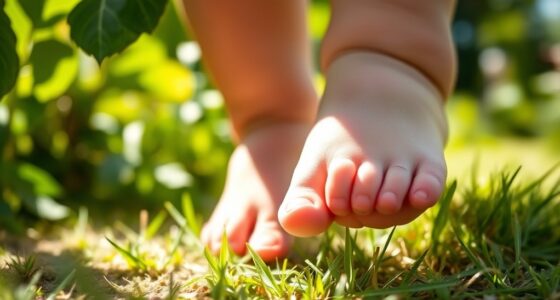To prevent wobbles, create fun activities that boost your toddler’s balance and coordination, like walking on low balance beams or crawling through obstacle courses. Use soft surfaces and supervise closely to guarantee safety while encouraging challenges that build strength and confidence. Turn exercises into games and celebrate small wins to keep your child engaged. Keep practicing regularly and gradually increase difficulty—if you keep at it, you’ll help develop a sturdy, confident mover.
Key Takeaways
- Incorporate fun obstacle courses with cushions, tunnels, and soft blocks to develop coordination and spatial awareness.
- Practice walking on low, wide balance beams to improve stability and confidence in balance.
- Use imaginative play scenarios like animals crossing logs to make exercises engaging and effective.
- Encourage crawling, climbing, and stepping over obstacles to strengthen core muscles and enhance coordination.
- Celebrate small successes to boost motivation and reinforce progress in balance skills.
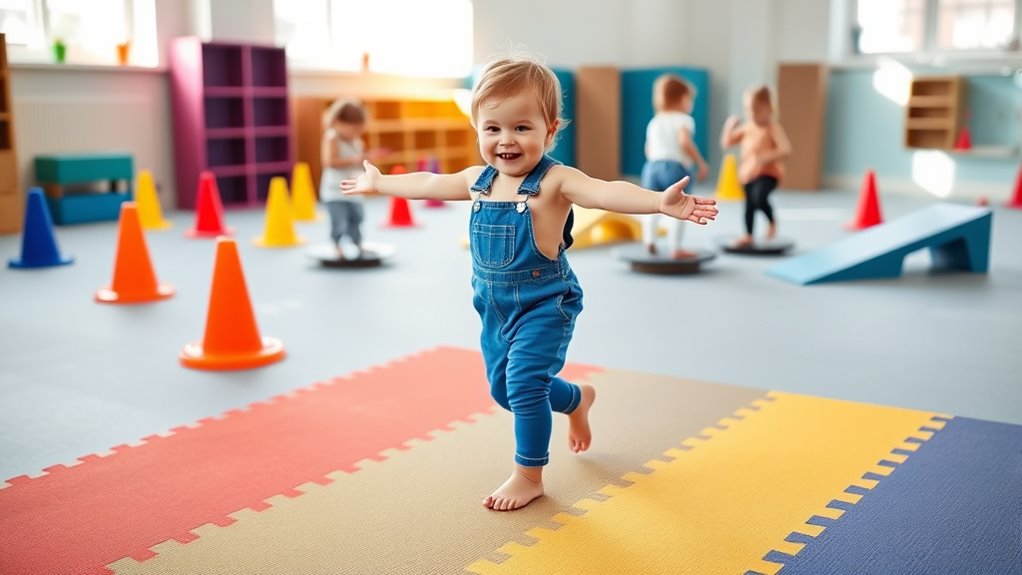
If you’re looking to boost your toddler’s confidence and coordination, a Toddler Balance Bootcamp can be a fun and effective solution. This kind of activity focuses on developing gross motor skills, which are essential for your child’s overall physical growth. As your little one learns to balance, crawl, and walk confidently, they build strength and coordination that will serve as the foundation for more complex movements later on. Plus, engaging in these activities can help reduce those wobbles and improve stability, making everyday tasks easier for your toddler.
When planning a balance bootcamp, safety should always come first. You’ll want to create a safe environment that minimizes the risk of falls or injuries. Start by choosing a soft, non-slip surface like a padded mat or carpeted area. Keep the space clear of furniture or sharp objects that your toddler could bump into. It’s also a good idea to supervise at all times, staying close enough to catch or support your child if they lose their balance. Using age-appropriate equipment, like small balance beams or stepping stones, can make activities both fun and safe. Make sure these tools are sturdy and stable, and avoid anything too high that could pose a fall risk.
Incorporate simple activities that encourage gross motor development and balance. For example, setting up a low, wide balance beam can help your toddler practice walking in a straight line while maintaining stability. You can also create obstacle courses using cushions, tunnels, or soft blocks, encouraging your child to crawl, climb, or step over obstacles. These activities not only promote core strength but also improve coordination and spatial awareness. Be patient and celebrate small successes—praising your toddler for trying will boost their confidence and motivate them to keep practicing.
Another helpful tip is to turn balance exercises into game-like activities. For instance, pretend to be animals walking on a log or crossing a river. This makes the experience enjoyable and less intimidating. Remember to keep sessions short and engaging, as toddlers have limited attention spans. Gradually increase the difficulty by adding more challenging tasks as your child’s skills improve, always ensuring safety tips are followed. The key is consistency and fun; your toddler will develop better balance, coordination, and confidence without feeling overwhelmed. With these focused activities and safety precautions, your little one will be wobble-free and ready to take on new physical adventures.
Frequently Asked Questions
When Should I Start Balance Activities for My Toddler?
You should start balance activities for your toddler as early as they begin to walk, usually around 12 months. Early intervention with simple activities supports their motor milestones and helps build confidence. Engage them in fun, safe exercises like standing on one foot or balancing on a soft surface. These activities promote their coordination and stability, setting a strong foundation for future motor development and preventing those wobbles as they grow.
How Can I Tell if My Toddler’s Balance Is Developing Normally?
Did you know that by age two, most toddlers can walk steadily and even run short distances? To tell if your toddler’s gross motor skills are developing normally, observe their balance during play. Good balance indicates healthy sensory integration and gross motor development. If your child can stand on one foot briefly or walk on uneven surfaces, they’re on track. If you’re concerned, consult a pediatrician for guidance.
Are There Specific Safety Precautions for Balance Exercises?
When doing balance exercises with your toddler, prioritize safety by using appropriate safety gear like helmets and knee pads. Always follow supervision protocols, staying close and attentive during activities to prevent falls or injuries. Guarantee the environment is safe, clutter-free, and supportive. Never push your toddler beyond their comfort zone, and stop immediately if they show signs of fatigue or distress. These precautions help make balance exercises safe and enjoyable.
What Are Signs My Toddler Needs Professional Assessment?
If you’re worried about your toddler needing a professional assessment, watch for signs like persistent motor delays or coordination issues. If your child struggles to sit, crawl, or walk at age-appropriate times, or if they seem clumsy or unsteady, these could be red flags. Trust your instincts—consult a pediatrician if you notice these signs, as early intervention can make a big difference in addressing potential developmental concerns.
How Often Should Balance Activities Be Incorporated Into Daily Routines?
When it comes to balance activities, practice makes perfect, so aim to include age-appropriate activities daily. You should incorporate them at least 2-3 times a day, ensuring you follow safety guidelines to prevent falls. Kids thrive on routine, so consistency helps build confidence and coordination. Keep activities fun and manageable, adjusting as your toddler grows. Regular practice will help prevent those wobbles and support their development.
Conclusion
Think of your toddler’s balance journey as guiding a tiny ship through calm and stormy seas. With each activity, you’re helping them steady their course, turning wobbles into confident strides. Remember, every stumble is a small wave that teaches resilience. With patience and practice, you’re nurturing a brave explorer ready to navigate life’s vast oceans. Keep steering gently, and watch your little one sail smoothly into a future of confident balance.

